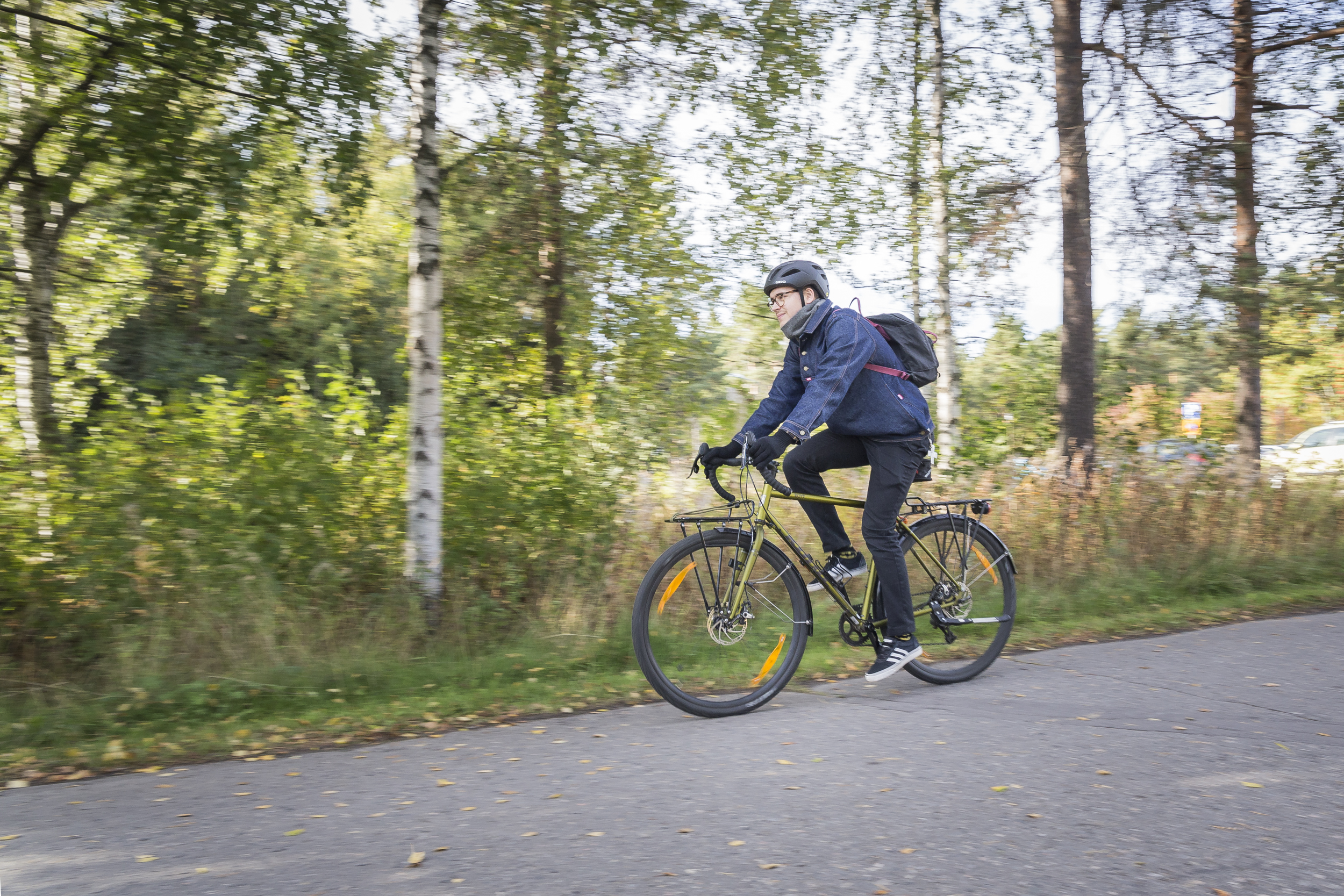It certainly is a cliché to call Oulu the Cycling City, but it is true.
There is a clear will to uphold the cycling city reputation: the city of Oulu has invested not only in the cycling routes and signs, but also to make cycling more interesting and accessible and to raise cycling awareness. Few examples are the new website for cycling in Oulu area, new road signs, and the long-awaited Sykkeli city bikes. There are Sykkeli stations near both Linnanmaa and Kontinkangas campus.
Cycling students arriving at the Linnanmaa campus on the red paved cycling route can’t help but notice the changes. Oulu Student Magazine interviewed two active cyclists and asked what they think about the changes and whether they see subjects for improvement.
Antti Nurmesmäki, a fifth-year chemistry student, tries to cover all his journeys by bike. He bikes to Linnanmaa campus almost daily.
“During my teaching practice I took a bus because I didn’t want to be sweaty when teaching”, Nurmesjärvi says.
In addition to daily exercise, cycling is also Nurmesjärvi’s hobby: his longest trip so far is cycling to Hailuoto and back in the summer, and he’s already planning a trip to Europe’s long cycling routes.
While getting some incidental exercise, Nurmesjärvi also points out that cycling saves money and refreshes.
“In the mornings I’m much more energetic than I would be if I’d just walked into a bus,” Nurmesjärvi states.
“When I started studying in Linnanmaa campus, there was no clear biking route and it was usual to laugh at how hard it is to find the way from the campus to the city centre. Now there’s a red carpet which is easy to follow.”
Nurmesjärvi finds his daily commute to the university has become faster, thanks to the new cycleways, although the road construction site in Alppila has temporarily slowed the journey. All in all, Nurmesjärvi praises the cycling projects of the city of Oulu, even though he, originating from Oulu, hasn’t personally benefitted from the numbered cycling routes.
He also thinks that the bicycle repair points installed in the city centre last year are really handy.
Like Nurmesjärvi, also Eemeli Bergström, a third-year geosciences student, is active cyclist both in his everyday life and in free time. He, too, is happy with Oulu’s cycleway network, which he thinks is quite extensive.

In addition to students, also others are pleased.
Pasi Haapakorva, the Chair of Oulun polkupyöräilijät ry (“Oulu Cyclists”, OUPO), states that Oulu is the best cycling city in Finland. In his e-mail response, Haapakorva tells about things that are characteristic to Oulu cycling infrastructure. These include possibility to cycle long distances without crossings as well as the density and extent of cycleways outside the city centre.
“When I started studying in Linnanmaa campus, there was no clear biking route and it was usual to laugh at how hard it is to find the way from the campus to the city centre. Now there’s a red carpet which is easy to follow”, Haapakorva writes.
Cycling culture in Oulu is great — but not perfect
Eemeli Bergström says that the cycling culture in Oulu is generally good. His basis for comparison is small cities in Australia, such as Kalgoorlie, where he has lived. He says that in Australia, drivers don’t take cyclists into account as well as in Oulu, which can be seen in the cycling safety.
According to Bergström, the attitudes toward cycling are good in Oulu and in Finland as a whole.
“In other countries biking is only for kids, here everyone bikes”, Bergström says.
Pasi Haapakorva, too, highlights the way drivers in Oulu are careful and give space to cyclists. He says that it’s understandable, since most likely also drivers cycle from time to time.
Antti Nurmesjärvi thinks that in general it is good to bike in Oulu. He, too, praises drivers’ attitudes towards cyclists, but stresses that there are regional differences in Finland. According to him, people in Oulu are more understanding when it comes to e.g. mistakes in the traffic, but this is not the case in the whole country.
“My friend who lives in Turku told me that if someone bikes on the pavement in the city centre, they might get punched.”
“In other countries biking is only for kids, here everyone bikes.”
Sometimes cyclist’s own behaviour can cause problems. Nurmesjärvi points out that it’s dangerous to hold a phone while biking and to bike in the dark without lights. He himself hasn’t been in dangerous situations because of these examples but finds them nevertheless annoying phenomena.
Still need for bike racks and streetlights
Even though the city of Oulu has significantly improved its cycling circumstances in the past few years, the city continues to invest in cycling infrastructure in the future as well: Oulu applies for state grant to continue the cycleway from Raksila to Mäntylä. This so called “Mäntybaana” is a part of over 60 km long cycleway network that is still in planning.
Also, the amount of Sykkeli city bikes and Sykkeli stations can in future change according to feedback.
Both students have their own suggestions on how to improve cycling in Oulu.
Both Bergström and Nurmesjärvi say that cycling arrangements in Linnanmaa area are adequate. Bergström points out that small amount of bike racks is a problem. But neither Bergström nor Nurmesjärvi finds bigger issues than that in the Linnanmaa campus area.
Instead of Linnanmaa, both students have suggestions on other areas in the city.
Nurmesjärvi hopes that the traffic arrangements for cyclists in the city centre were clearer. He raises Rotuaari as a problem: for cyclists it’s hard to know where biking is allowed and where it isn’t. Bergström, too, thinks that cycleways in the city centre should be clearer.
In addition to the city centre, other areas have problems as well. Bergström, who lives in Toppila, mentions that from his point of view, the most problematic is the lack of street lighting on the way to Linnanmaa. He says that the dark areas do have streetlights, but they are rarely on.
Neither of the students have used the Sykkeli city bikes, but they still see them as a positive thing. During his exchange in Slovenia, Nurmesjärvi got to know the city bike culture there. He sees the city bikes as a valuable addition to public transport here in Oulu as well and is interested in trying Sykkeli.
This autumn, the city bikes have been the cause of harsh criticism because of their difficult interface and technical problems. The procurement and mobilisation of Sykkelis didn’t go as planned: the bikes were planned to be in use in the beginning of the summer but because of reasons unrelated to the city, they were ready for use at the end of August instead. Because the city bike season ends at the end of October, the time for using Sykkelis was brief this year.
The red-surfaced cycleway has also had its problems: in the middle of October, Kaleva wrote about the cycleway’s slipperiness and therefore causing accidents. According to Harri Vaarala, the traffic engineer interviewed in Kaleva’s article, the impression of slipperiness is caused by the fact that new asphalt tends to be more slippery than old asphalt.
Editor’s comment
“As a cyclist I’m quite lazy. My bike has been waiting the day I’d bring it with me for a shamefully long time. In my first year in the university, I covered most of my daily trips by bike, even though I wasn’t as active as the students interviewed in this article. I don’t find cycling itself unpleasant, but everything that comes with it. Maintaining the bike, planning the route, and preparing for the weather started to feel bland. Hopping in the bus is easy, especially if you only go between Linnanmaa and the city centre as I do.
Most of the problems that I had as a cyclist have been solved in the past few years. As a first-year student without any sense of direction I would’ve needed the numbered cycleways that we now have in Oulu. Now, an easy route to south from Linnanmaa and back exists, and the road construction works have eased off.
My excuses have become weaker, and before the city bikes I could make excuses how my bike is old and hard to pedal. Thanks to Sykkeli’s initial problems, the lazy cyclist had another excuse to walk or take a bus.
Now that the Sykkelis are about to go to hibernation, it may be that I, too, will put off starting the cycling until the next spring.”
Translation: Essi Ranta.


